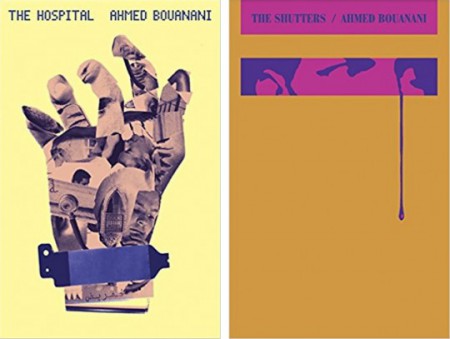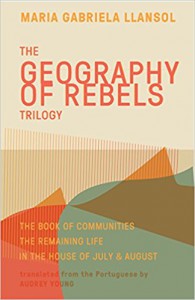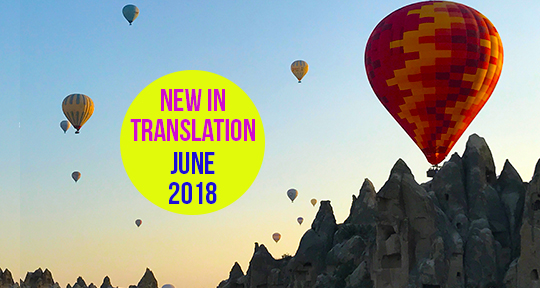Time for another round of translations hitting bookstores this month. June sees the publication of new translations from Morocco and Portugal. As always, check out the Asymptote Book Club for a specially curated new title each month.

The Hospital (translated by Lara Vergnaud) and The Shutters (translated by Emma Ramadan), from the French by Ahmed Bouanani, New Directions, 2018
Reviewed by Poupeh Missaghi, Iran Editor-at-Large
Two books by Ahmed Bouanani, Moroccan writer, poet, illustrator, and filmmaker hit the English literary scene this June.
The Shutters brings together two collections of poetry, The Shutters (1980) and Photograms (1989), and is translated by Emma Ramadan. In both collections, Bouanani looks back, but this looking back is not with a sense of nostalgia for a glorious past or a desire to return to a happy place, but is rather pointed towards a loss, an open wound, deep and ancient. Memory, dreams, and hallucinations are constant themes. Loss of childhood weaves together with anecdotes of ancestors, tales of a house, violence of wars and governments, silence and absence. The burden of history and death become harrowing presences all throughout the alleys of the book. Sadness builds up to become its own mantra, reconfiguring itself into a beauty as we read on and arrive at lines such as: “A people without memory is a people without name” (70), “For if the living often dream the dreams of the dead / the dead undream the dreams of the living” (75).
The other book by Bouanani, The Hospital, is a novella dating back to 1990 and translated by Lara Vergnaud. The story is narrated by an “I” who is a writer committed at a hospital (Bouanani himself suffered from tuberculosis in his life), who, moreover, is writing about his experience of being “a prisoner of the hospital or my body, stripped of everything, even my memory” (125).
Located out of the city, surrounded by walls, with a gate that seems to have disappeared, and situated outside of time, the hospital brings together a gang of madmen who seem to be trapped there for eternity: “And my companions? For the most part they no longer have a good reason to leave, lost as they are in the density of their dreams. As for me, I feel like I came here for the day, two weeks or a century ago, and forgot to leave. Where would I go?” (55) As if forgotten by the world outside and left to their own means to rot, the men spend their days and nights in a purgatory between reality and nightmares. They float between hallucination, delirium, memories, and imagination, revisiting their pasts, their people, and their places. Once again, memory, loss of childhood, and violence have a strong presence throughout Bouanani’s work: “What I saw was my own younger corpse, the one from old photographs not good for anything anymore, not even to make me fleetingly relive the old terror of nights . . .” (103-104).
But it is not all extremely dark and dire. The bonds that the men build with one another are deep and strong. They care for one another, share stories with one another and, through the narrator, with us. Within all the pain, they find a space for humor, as if they are a gang of young boys out camping: “Fartface turned towards me. ‘Hey, Smart-Ass! I get a kick out of you writing a book about us and all, but careful, not a word about what I said earlier, and whatever you do, don’t mention my diarrhea, it won’t leave a good impression, and come on, what will future generations think of a guy like me, huh? Okay? Agreed!?’” (102). Bouanani’s labyrinthine hospital is filled with suffering, solitude, and sorrow, but life there does insist on breathing, in and out, slowly and beautifully, until it can’t.
The Hospital also includes an introduction, by Anna Della Subin, and The Shutters a foreword, by translator Emma Ramadan, that are not to be missed.

The Geography of Rebels Trilogy by Maria Gabriela Llansol, translated from the Portuguese by Audrey Young, Deep Vellum Publishing, 2018
Reviewed by Lindsay Semel, Portugal Editor-at-Large
All of the inhabitants of Maria Gabriela Llansol’s Geography of Rebels Trilogy, translated from the Portuguese by Audrey Young, are historically real, but it wouldn’t be accurate to call the text a history, or historical fiction. The style doesn’t fit neatly into classifications of prose or poetry. There is no plot to speak of, but each action, often minute or even internal, is related with the utmost urgency by a shapeshifting, somehow feminine narrator. The access points to the text are its allusions and its images. Llansol, who lived for nearly twenty years in exile in Belgium because of the dictator Salazar’s oppressive regime, does well to describe the text as a geography—a space at once real and imaginary where a group of individuals, at once real and imagined, exist, communicate, and offer themselves in spiritual devotion to the simultaneously divine and worldly.
The trilogy is comprised of three novellas: The Book of Communities, The Remaining Life, and In the House of July and August. Though with continuity of characters, style, and themes, little plot, and structures that provoke speculation rather than providing stability, the reader has plenty of liberty to muse about the connections and distinctions between the three. The same can be said of conventions like spacing, punctuation, line breaks, and page layout. At once illogical and impactful, they invite active, participatory reading, which attests to the skill of Young’s translation. To maintain across languages such deliberate and such unconventional units of meaning with weight, grace, and whimsy is an impressive feat.
Allusion grounds the reader. It creates meaning by anchoring the text to a larger historical, spiritual, and literary narrative. The trilogy is peopled by a cast of religious rebels. Carmelites, Cathars, Beguines, and even Sufis, they live by and write of an unmediated love for God, often compared and intertwined with earthly loving relationships. They choose lives of poverty, they care for the poor and sick, they write, and they criticize (and in turn are persecuted by) the Catholic Church. These rebels form a community that transcends time and geography, united through their common ideals and most crucially, through the exchange and inspiration of words. In this way, the voice of the narrator, however unfixed, includes herself in the community.
Take, for example, Saint John of the Cross. This persecuted Carmelite saint, one of the most consistent characters throughout the trilogy, who appears both dead and immortal as lover, child, saint, and writer, penned The Living Flame of Love for Doña Ana de Peñalosa, another recurring figure in the Geography. With little direct exposition, the narrator alludes to it often. In The Living Flame, the love of God is the flame, which burns brighter and spreads as it transforms the wood, the human soul, and joins it to itself. The inflamed soul speaks. The inflamed and speaking soul is a contagious characteristic of the text’s community members. Through dislocating body parts, using pronouns inconsistently, overlapping images, and other devices, boundaries between one and another character remain unreliable: “I smile; and, having found it underneath the page, I held my severed hand to my chest; Saint John of the Cross, or my son, they write in vain on the blank page. Always blank there was no writing: he then lay down upon the paper, his body taking on the proportions of a newly born child.”
It is interesting to note how depictions of femininity evolve over the course of the trilogy. In The Book of Communities, there is a powerful and essentially (not completely) solitary feminine presence (often identified with Ana de Peñalosa) who accumulates a set of men (Saint John of the Cross, Thomas Müntzer, Nietzsche, and others) around her. They are at once her children, her lovers, her muses, dead, and present, as they exist in a series of places. One striking image depicts a woman who is a thought in the mind of a horse awaiting a storm: “Man must relinquish power and woman must relinquish man. . . As she cooked on the grill, the master in the art of thinking experienced the feeling of being a rose, of continually opening up into petals and perfumes, of being the lady where the monstrous hunger ends, and of the ability to quickly bear children, take them out from under her skirt, only a moment between making love and producing children.” In The Remaining Life, the female narrator shares her husband with Hadewijch, a mystic Beguine-turned-wanderer who wrote about love for God in the style of French courtly love. In this tender scene, the writing occupies only half the page: “Mother of objects, I deliberately left the other side of the page blank.” The narrator asks Hadewijch who “was loved by him, and loved us” her permission to offer her to her husband. After a silent assent, the narrator undresses Hadewijch, starting with her bottom half, and then “I left slowly, cautiously, at the center of a chaotic/mixture of happiness and suffering, which I tried/to sort out so I could begin writing.” Finally, in In the House of July and August, the cast becomes larger, mostly female, and more anonymous. We’re given often only first names as clues to their identity.
I read the Geography of Rebels Trilogy very slowly, with my journal at hand and Google accessible. Both were indispensable. At first, I was frustrated with myself, that I couldn’t digest even a few pages without scribbling my own unrelated thoughts. But to write back is exactly the text’s invitation to the reader, just as the text itself writes back to earlier ones, which in turn converse with each other.
*****
Read more recent reviews from the Asymptote blog:

